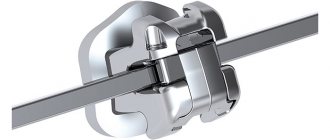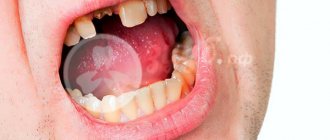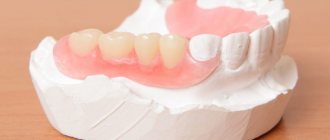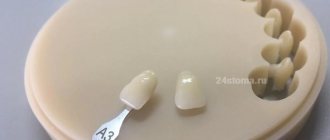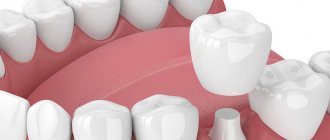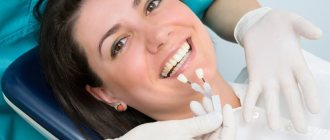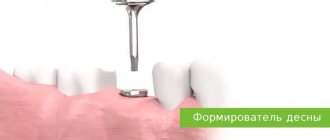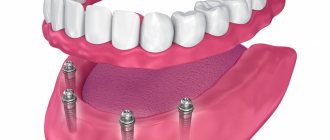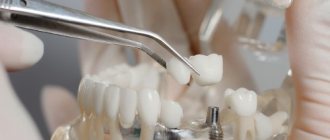- Questions and answers
- Stock
- Reviews
- Prices
- Methods and steps
| Prices | Technologies and stages | All-on-4 prosthetics | All-on-6 prosthetics |
Today, there are various implantation technologies for complete absence of teeth, which are used depending on the clinical picture and financial capabilities of the patient. What are the features of these methods? How to choose the optimal technology? How much does it cost to get full dental implantation in Moscow at NovaDent dental clinics?
Five important questions about how to insert teeth
Before describing technologies for restoring lost teeth, we will briefly answer the most popular questions that interest almost all patients who are faced with the need for prosthetics for the first time.
- Do I need to replace teeth if I have lost them?
Dentists recommend doing this immediately and without fail. Even if the emptiness in the dentition is unnoticeable, do not delay your visit to the clinic. Lack of timely treatment leads to resorption of bone tissue, displacement of the dentition, deterioration of the bite, and can cause changes in the shape of the face and problems with the digestive system. - What teeth can be inserted?
Absolutely everything: natural incisors, canines, molars and premolars can be successfully replaced with dentures. - Does it hurt to put teeth in?
Many patients familiar with the methods of Soviet dentistry are concerned about the question of whether it hurts to insert teeth? We hasten to reassure you: modern methods of anesthesia make the treatment absolutely painless. - How long does it take to insert teeth?
It all depends on the treatment method, the efficiency of the doctors and the dental laboratory. Temporary teeth can be inserted in one visit; permanent dentures require more time. - What is the name of the doctor who inserts teeth?
The doctor who inserts teeth and performs prosthetics is an orthopedic dentist, but treatment and preparation for procedures is usually carried out by a whole team of specialists: dental surgeons, dental therapists, dental technicians.
Why is the cost of installing prostheses different in different clinics?
Patients who are indicated for the installation of orthopedic structures, as a rule, are interested not only in restoration methods, but also in how much dental prosthetics costs in various medical institutions. And they discover that edentulous treatment can cost differently even when using approximately the same techniques and materials. This is due to several factors.
In particular, the cost of prosthetics is influenced by the experience of doctors and their level of qualifications, which is confirmed by the presence of international certificates. In addition, prices for services may depend on the type of ownership and attendance of the clinic, the cost of renting premises, and the type of equipment used. Naturally, the cost of treatment will be higher in a well-attended private dental clinic, equipped with new technological equipment, and staffed by experienced, highly qualified doctors.
All modern methods of restoring lost teeth
Just 20 - 30 years ago, metal teeth in the front part of the jaw were not considered something shameful. Moreover, many dreamed of inserting gold teeth, since a golden smile was associated with wealth. Today, dental treatment is technologically advanced, effective and painless, and there are many more ways to insert teeth. Despite the variety of dental services, it is very important for the patient to find good dentistry and a competent specialist who will provide professional assistance. There are hundreds of reviews online where people complain that their teeth were inserted poorly or that the inserted tooth hurts. Unfortunately, such consequences are not uncommon, and their elimination requires repeated treatment and additional costs.
All prosthetic methods are divided into two types: single restoration and complex prosthetics (when you need to replace several lost units or insert complete teeth). Single restoration in most cases is carried out using special inlays (veneers or lumineers) and crowns that are installed on natural teeth or implants. When several teeth are lost or completely edentulous, bridges or removable dentures are used, supported by implants, natural teeth or the oral mucosa. Let's look at these designs in more detail and start with regular dental crowns.
- Metal-ceramic teeth
The crown is based on a metal frame, onto which layers of ceramic are applied under the influence of high temperatures. Such designs are relatively inexpensive and are used for prosthetics of front teeth. Metal tends to oxidize, so over time a bluish outline may form around the gums, which has a bad effect on aesthetics. - Ceramic tooth
These crowns are indistinguishable from natural teeth. Modern ceramics are installed both on the anterior units and on the chewing teeth. The price of ceramic crowns is perhaps their only drawback. The cost of such products is higher than that of similar structures using a metal base. This is why not every patient can afford to have a ceramic tooth inserted. - Zirconium teeth
Today, zirconium dioxide crowns are considered the best of similar designs available on the market. They are as durable as metal crowns, and in aesthetics they are not inferior to ceramic structures. With the help of zirconium crowns, teeth are successfully inserted in any area of the jaw, but when planning to restore lost units, take into account the fairly high cost of such crowns.
Fixed and removable prosthetics
There are two main methods of prosthetics. Removable dentures are considered a budget option and are suitable for those who cannot afford full prosthetics, but they have a number of disadvantages, unlike a fixed structure. Let's take a closer look at each of these methods and their costs.
Removable prosthetics
In case of significant tooth loss, removable dentures are used
The name itself suggests that prostheses of this type can be removed and installed at will. Indications for this type of prosthetics are carried out in cases where there is significant loss of teeth and there is no budget for full prosthetics.
There are several types of removable dentures:
- Bugatel
- Nylon
- Acrylic
Depending on the material of manufacture, the price varies from 10,000 to 25,000. A good, budget option for retirees.
Thanks to modern technologies, you can purchase a removable denture made of soft and comfortable material that will last for many years.
The disadvantages include the need to constantly remove and put on the prosthesis, and there is also the possibility that the crown may lag behind. Nuts, fresh fruits and vegetables should be eaten with great caution. The same goes for toffees and similar products.
Fixed prosthetics
All fixed dentures can be divided into three main categories:
- Crowns. They are used when one tooth or several are missing in different places of the jaw.
- Bridge overlays. Used when several teeth are missing in a row
- Veneers. Used to create the effect of a beautiful snow-white smile, as well as in cases of visual defects in the front teeth
Of course, the main advantage is durability and reliability. An obvious disadvantage is the high cost of prosthetics, which not everyone can afford. Especially in cases where a significant number of teeth are missing. In order to install dentures on both jaws you will have to pay from three to ten thousand dollars. For Russia the amount is significant. However, many clinics are ready to provide installment plans or loans.
A fixed denture looks indistinguishable from natural teeth and lasts longer than a removable one.
When it comes to a younger age, it is better to fork out for a fixed type of prosthetics, since such dentures will last longer, and the appearance is practically indistinguishable from natural teeth. However, here the choice remains with the patient.
Which crown to choose
Most of all, patients are interested in the cost of crowns and their aesthetics. Of course, you can choose a prosthesis yourself, focusing on your financial capabilities and ideas about beauty. But it is better if a doctor does this. Before starting the restoration of the dentition, the dentist evaluates the condition of the root system, gums, mucous membrane, tissues of the root part and cervical area. When choosing a prosthetic method, it is important to exclude all contraindications. They differ depending on the method of tooth restoration. The most serious are diseases of the immune system, oncology, uncompensated diabetes mellitus and periodontal inflammation. The doctor’s task is to choose the safest prosthetic option for the patient and the one that best suits the clinical picture.
Implantation: indications and benefits
Implantation is the most advanced dental technique that allows you to insert a tooth in place of an extracted one.
- Implants eliminate dental defects of any location and extent.
- People quickly get used to the implants. There is no discomfort, no sensation of the presence of a foreign body in the oral cavity, no problems with chewing food.
- Before implantation, there is no need to grind and depulp adjacent teeth; they remain healthy.
- Implants do not need to be changed or adjusted. With proper implantation and personal hygiene, artificial roots can last a lifetime.
- Even under increased loads, there is no risk of implants falling out or loosening.
How is an implant inserted?
The essence of this technique is to implant a titanium root into the jaw, on which a crown is subsequently installed. On average, implant healing takes from 2 to 6 months. During this time, a temporary orthopedic structure is installed for the patient’s convenience.
There are protocols for immediate implantation. Modern structures can be inserted after tooth extraction and immediately loaded with a prosthesis. Many patients are interested in whether it is painful to insert a dental implant. In fact, implants are installed quite quickly (15 - 20 minutes per tooth), and an injection of anesthesia allows you not to feel pain. If you have severe dental phobia, the doctor will suggest inserting teeth under anesthesia or sedation.
Why do you need to restore your teeth?
Edentia is not only discomfort, but also early aging. The absence of teeth leads to changes in facial features, sunken cheeks, and the appearance of deep wrinkles. The person looks older, his appearance becomes sickly. In addition to visible imbalances in proportions and a deterioration in the quality of life, when there are no teeth at all, health problems
:
- The diet is reduced, the body does not receive the required amount of vitamins and minerals. The immune system suffers, metabolic processes are disrupted, and cells do not receive enough nutrients.
- Gastrointestinal diseases are provoked. Food is chopped poorly, making digestion difficult. Sometimes patients switch to eating pureed food or pureed food - this method also contributes to the appearance of dysfunction of the stomach and intestines.
- The absence of teeth in the jaws leads to improper distribution of the load on the gums and bone. Tissues atrophy and become thinner.
The bite also changes, diction is impaired - speech is slurred, most sounds are distorted. The absence of teeth affects the emotional state, lowers self-esteem, and the circle of friends narrows. Researchers have also established a direct connection with the presence of teeth and the state of intelligence and activity of older people.
Methods for restoring anterior and chewing teeth
In the absence of teeth, the best way would be implantation, but if you have contraindications to this procedure, there are alternative options - installing a bridge with grinding of adjacent elements or a soft removable denture with clasps.
The same designs are used for chewing teeth: crowns, implants, removable and bridge dentures. The peculiarity of chewing teeth is that they are subject to heavy loads, so especially strong crowns made of zirconium dioxide or metal-ceramics are usually installed in this section.
If you need to insert 1 tooth
To restore one badly damaged tooth, an orthopedist may suggest a crown. If a tooth is missing, a bridge or implantation is required.
If you need to insert a tooth in place of a removed one
After removing a tooth, it is advisable to insert it within 1 – 2 months, since after some time the processes mentioned above begin to occur. If you want to completely restore the functionality, aesthetics, and anatomy of your tooth, dental implants are your best choice.
If you need to insert three teeth
In modern dentistry, to replace three lost teeth (in a row), a bridge prosthesis on implants is usually installed. If there is a limited budget or there are contraindications to implantation, the prosthesis is placed on the ground adjacent teeth.
If you need to completely insert teeth
Teeth restoration in cases of complete edentia is carried out using removable dentures. The best option is considered to be designs supported by implants, which guarantee the patient a good quality of life. In other cases, removable dentures are used with support on the mucous membrane and soft tissues.
Technologies and stages
Implantation for edentulous patients does not imply the installation of a separate implant for each dentition defect, since this is expensive and not always possible. Depending on the situation, from 4 to 10 implants are installed on one jaw, on which a bridge prosthesis of a conditionally removable or fixed type is then fixed.
In our dental center, implantation in cases of complete absence of teeth is carried out in several stages:
- Diagnostics
- includes examination, patient interview, computed tomography of the jaw and referral for blood tests (clotting factors, allergy tests for plastics and metal). The purpose of the medical examination is to determine the condition of the bone tissue, the anatomical features of the jaw system, and contraindications to implantation. - Planning
is carried out using 3D modeling, which allows you to select the optimal parameters of the implants, determine the angle of inclination and their positioning in the jaw bone. - Surgery
– implants are screwed into the bone during one visit to the dentist. If possible, titanium rods are implanted using a gentle method through punctures in the gums. - Prosthetics
– on the day of surgery or after removing the sutures on the gums (after 7 days), temporary bridges made of durable plastic are fixed on the abutments. After 1-3 years, the temporary prosthesis is replaced with a durable metal-ceramic, ceramic or zirconium structure.
Implantation of implants and fixation of new dentures lasts from 2 to 7 days, after which the patient enjoys a healthy smile and can chew food normally.
Recently, implantology has been moving away from classical approaches in favor of innovative prosthetic technologies with fewer supports. The most popular methods: All-on-4 and All-on-6.
Prosthetics on 4 implants using All-on-4 technology
All-on-4 technology (all on four) is the most economical method of implantation, developed and patented by the Swiss company Nobel Biocare. The technique involves implanting 4 root-shaped implants into the jaw with simultaneous loading. Titanium rods are installed according to the following scheme:
- 2 implants – in the front part of the jaw parallel to the patient’s natural teeth;
- 2 implants – in the area of 5-6 premolars at an angle of 30-45°.
Thanks to this arrangement of artificial roots, complete implantation of the jaw provides high primary stabilization of the prosthesis and does not require surgery to augment bone tissue. These factors allow you to immediately move on to prosthetics.
At the NovaDent center, 4-on-all jaw implantation is carried out using dental implants: Nobel, Astra Tech, Osstem, Dentium, Mis, Ankylos.
Read more about the technology, pros and cons, and duration of the operation in our article: All-on-4 implantation.
Prosthetics on 6 implants using All-on-6 technology
All-on-6 technology (all on six) is another development of Nobel Biocare, which consists of installing 6 implantable supports with instant loading into the jaw. The rods are implanted according to the same principle as in the case of All-on-4:
- 4 implants – in the front part of the jaw;
- 2 implants – in the area of the fifth chewing tooth.
In most clinical cases, we recommend that patients undergo implantation using the All-on-6 method, since this technology provides higher reliability of the prosthetic structure.
Prosthetics supported by 6 implants are almost always used to restore teeth in the upper jaw and are strongly recommended in the lower jaw with insufficient bone density.
Applied implantation systems: Nobel, Astra Tech, Osstem, Dentium, Mis, Ankylos.
See examples of the work of Novadent dentistry implantologists.
Is it possible to insert teeth without grinding down the adjacent ones?
Before installing classic dentures with fixation on natural teeth, preparation is required. Without grinding, restorative procedures are carried out using plastic structures with special clasp hooks that clasp the neck of a healthy tooth and thus hold the prosthesis in the oral cavity. The production and installation of such prostheses occurs much faster than in the case of overlay prostheses on implants, but you should not count on recovery in one day. If we are not talking about temporary prostheses, the creation of structures, fittings, and corrections can take several weeks.
Treatment prices: which teeth are better to insert on a limited budget
The cost of restoring one or more teeth depends on the treatment method and your budget. The most expensive treatment involves the use of implants. The cheapest thing is dental crowns.
| Insert teeth under anesthesia | An anesthesia injection costs on average 500 - 800 rubles. Treatment under general anesthesia - from 4,000 rubles (30 minutes). Sedation will cost from 1,500 rubles for half an hour. |
| Insert ceramic tooth | From 15 thousand rubles depending on the level of the clinic |
| Insert metal ceramics | From 9 thousand rubles. Depends on the metal alloy used |
| Insert a dental implant | 15 - 25 thousand for installing a budget brand of implants. 35 -50 thousand for a premium implant |
| Insert teeth completely | A removable denture on implants for one jaw costs on average from 120 to 250 thousand rubles (depending on the number of implanted implants and their brand). A regular removable denture will cost 25-50 thousand for one jaw |
| Insert zirconium teeth | From 25 thousand rubles depending on the level of the clinic. |
Where to get teeth inserted in Moscow?
There are thousands of clinics in the capital, most of which offer almost all types of dental restoration (crowns, implants, removable and bridge dentures). Choosing a clinic is quite difficult, so we advise you to pay attention to important nuances. Study the clinic’s website: it should contain detailed information about specialists, treatment methods and technologies, as well as relevant diplomas and certificates. Read patient reviews about dentistry on third-party resources. Directly during the consultation, do not be afraid to ask questions and find out details. A good doctor will always give comprehensive information and offer various treatment options. The search engine on our website will help you find reliable dentistry.
Prices
| Service | Price |
| Prosthetics with partial removable plate dentures | from 17,000 rub. |
| Prosthetics with partial removable lamellar dentures (immediate denture) | from 7,500 rub. |
| Prosthetics with removable clasp dentures | from 40,000 rub. |
| Dental prosthetics with complete removable plate dentures (immediate denture) | from 8,000 rub. |
| Restoring the integrity of the dentition with fixed bridges (tooth) | from 14,700 rub. |
| Restoring the integrity of the dentition with fixed bridges (crown) | from 18,400 rub. |
To avoid possible misunderstandings, please clarify the cost of services in clinics with the administrator or during a consultation with a doctor. Prices on the website are not a public offer.
Sign up for a consultation
